Are you a Quiet Speculation member?
If not, now is a perfect time to join up! Our powerful tools, breaking-news analysis, and exclusive Discord channel will make sure you stay up to date and ahead of the curve.
New metagames can be hard to pin down, as fresh cards lead to new brews and new tech, forcing established decks to adapt. This forces the new decks to adapt to the new pressure, and their success or failure creates ripples through the metagame. With War of the Spark and Modern Horizons released in quick succession, Modern is undergoing considerable churn.
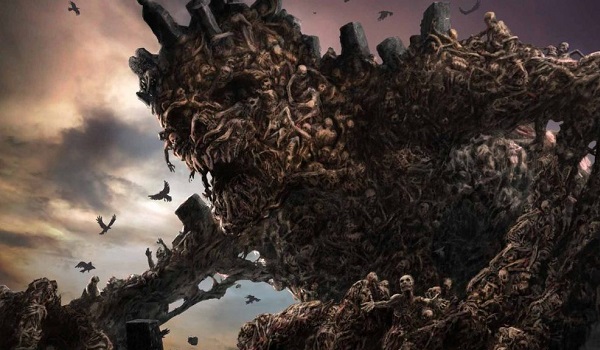
Under normal circumstances, there would be SCG Open or Grand Prix results to start analyzing for new metagame trends. That's not happening this time. The next big Modern event is GP Dallas at  the end of the month. Even once that data is in, it will almost immediately be mooted as a metagame indicator, because the metagame will be shaken up further wiith Core 2020 two weeks later.
the end of the month. Even once that data is in, it will almost immediately be mooted as a metagame indicator, because the metagame will be shaken up further wiith Core 2020 two weeks later.
If that isn't enough, Core 2020 will also inaugurate the London Mulligan to the general public. While the exact impact of this change on Modern is unclear, there is little doubt that it will have a huge impact on Modern. Given that Modern hasn't fully absorbed the previous two shocks yet, the two following shocks ensure that there is no definitive Modern metagame yet. However, some decks are rising to the top, and they're worth investigating in detail for clues about Modern's future.
Crossing Hogaak's Bridge
The results we have so far come from MTGO, and given Wizards' policy of curating the League lists, the only reliable metagame data comes from the Challenges. The first Challenge was dominated (though not won) by Hogaak, Arisen Necropolis-fueled combo decks. The second Challenge was won by Hogaak, though the deck's total placings were down. 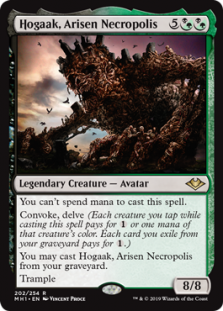 Hogaak took 10 of 32 places in the first Challenge, and six of 32 in the second. These impressive results, coupled with the potential for early kills, has already spurred streamers and other pundits into ban mania.
Hogaak took 10 of 32 places in the first Challenge, and six of 32 in the second. These impressive results, coupled with the potential for early kills, has already spurred streamers and other pundits into ban mania.
The combo works by first finding Hogaak, either by drawing it naturally or via Faithless Looting/Insolent Neonate, or by milling it with Stitcher's Supplier/Stinkweed Imp. Hogaak then needs to be cast from the graveyard by convoking at least two black or green creatures and delving away the rest of his cost. From there, Hogaak is sacrificed, ideally to Altar of Dementia, to generate Bridge from Below tokens. With Altar out, the combo becomes self-sustaining, as you mill your whole deck. It then turns into an outright win, as all tokens made during the loop are sacrificed to empty an opponent's library. The absolute perfect draw kills on turn 2, and more reasonably turn 3. Without Altar, the combo will peter out at some point, but not before building an overwhelming board presence.
History Check
If this sounds familiar, it should. Hogaak-Bridge is just the latest version of Bridgevine, as in the core of the deck is completely unchanged and room's been made for new cards. Last August Bridgevine appeared on the scene, and almost the exact same mania occurred. The deck was seemingly everywhere following it's debut at PT 25th Anniversary. But within a few months, the threat had completely subsided. Bridgevine has a lot of fundamental weaknesses which, once known, were easy to exploit and defeat. Hogaak has changed the deck, but not enough that I can't see history repeating itself.
The More Things Change...
The main difference between Hogaak and the older version of Bridgevine is kill speed. The best Bridgevine hands generated an unanswerable board turns 2-4 and then actually won the turn afterwards. There's very little way to answer three hasty 4/3's that early, not to mention all the tokens. Hogaak can do the same thing, but under the right circumstances, outright wins via decking the same turn it goes massive. I'd argue that the functional kill speed is about the same as before, but the actual kill is slightly faster, which makes it harder to disrupt.
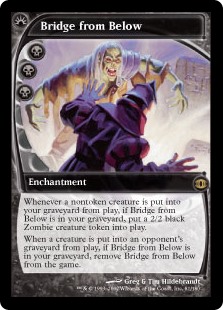 The other advantage is that Hogaak isn't a glass-cannon aggro deck. If the fast kill didn't come together or was somehow answered, Bridgevine didn't have any other options. Altar gives Hogaak a valuable second angle of attack. Bypassing the combat step closes a significant vulnerability for Bridgevine. Before, Bridgevine would lose to a fast Ensnaring Bridge or Anger of the Gods destroying their board. They could rebuild from Anger if Viscera Seer was on-board, saving their Vengevines and scrying into gas. However, losing the combat step was a significant setback.
The other advantage is that Hogaak isn't a glass-cannon aggro deck. If the fast kill didn't come together or was somehow answered, Bridgevine didn't have any other options. Altar gives Hogaak a valuable second angle of attack. Bypassing the combat step closes a significant vulnerability for Bridgevine. Before, Bridgevine would lose to a fast Ensnaring Bridge or Anger of the Gods destroying their board. They could rebuild from Anger if Viscera Seer was on-board, saving their Vengevines and scrying into gas. However, losing the combat step was a significant setback.
It seems clear that Horizons has made Bridgevine faster and more versatile. Normally, this would be enough to say that the new card signifiantly improved the deck. In this case, I hesitate. Kill speed and vulnerability to disruption were not the problems that drove off Bridgevine last year, and Hogaak and Altar haven't fixed them.
...The More They Stay the Same
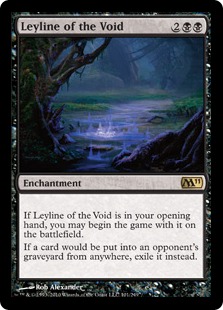 Bridgevine had its moment last year, and then faded away. Odds are, the same will happen to Bridgevine now. Altar has given Bridgevine another win condition and Hogaak has made it more of a combo deck, but they haven't fundamentally altered the deck. Bridgevine was, and Hogaak-Bridge is, one-dimensional in that it cannot function without a graveyard. Any hate causes the engine to splutter out and become 1/1s-with-menace-beatdown. Bridgevine could theoretically power through thanks to Goblin Bushwacker, but Hogaak is far more invested in the combo plan. The deck loses to Rest in Peace/Leyline of the Void unless they find enchantment removal.
Bridgevine had its moment last year, and then faded away. Odds are, the same will happen to Bridgevine now. Altar has given Bridgevine another win condition and Hogaak has made it more of a combo deck, but they haven't fundamentally altered the deck. Bridgevine was, and Hogaak-Bridge is, one-dimensional in that it cannot function without a graveyard. Any hate causes the engine to splutter out and become 1/1s-with-menace-beatdown. Bridgevine could theoretically power through thanks to Goblin Bushwacker, but Hogaak is far more invested in the combo plan. The deck loses to Rest in Peace/Leyline of the Void unless they find enchantment removal.
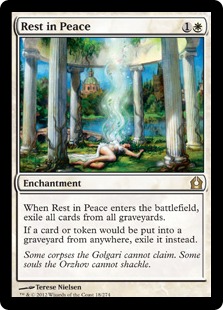 The other problem is one that Bridgevine shared with another deck that exploded into Modern then faded away, Hollow One. Both decks relied on randomness going their way to really function. For Bridgevine, that meant Stitcher's Supplier hitting Bridges and Vengevines off the top of the library. For Hollow One, that meant drawing but not discarding its fatties with Burning Inquiry or Goblin Lore.
The other problem is one that Bridgevine shared with another deck that exploded into Modern then faded away, Hollow One. Both decks relied on randomness going their way to really function. For Bridgevine, that meant Stitcher's Supplier hitting Bridges and Vengevines off the top of the library. For Hollow One, that meant drawing but not discarding its fatties with Burning Inquiry or Goblin Lore.
When the Random Numbers God favors these decks, they prove crushingly powerful. However, the RNG is characteristically fickle. Hollow One and Bridgevine fell off because they lost to themselves as often as they exploded onto their opponents.
Hogaak has the same problem. There is no guarantee that the combo will actually go infinite. The copies of Bridge from Below that make it possible may not show up from the first Altar activation, or even a second. In those cases, the deck doesn't do anything. Given that Hogaak-Bridge retains the most pressing weaknesses of its predecessor, I would expect its Modern run to play out similarly.
Impact and Implications
If history is instructive, the return of Bridgevine won't have a lasting impact on the 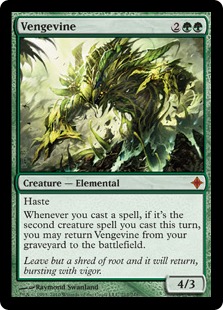 metagame. It didn't last time, and the Hogaak combo hasn't made the deck better enough for me to believe that will change. Long-term, Hogaak will remain a threat, but a manageable one so long as the metagame doesn't forget about it. In the short term, I expect fewer Surgical Extractions and more broad-pattern graveyard hate.
metagame. It didn't last time, and the Hogaak combo hasn't made the deck better enough for me to believe that will change. Long-term, Hogaak will remain a threat, but a manageable one so long as the metagame doesn't forget about it. In the short term, I expect fewer Surgical Extractions and more broad-pattern graveyard hate.
Surgical is very good at stopping the combo (Hogaak must be cast as a normal creature), but it's not very good at stopping the deck. Hogaak is a huge threat, as are the Bridges and Vengevines. You need to kill the whole graveyard to effectively shut down the deck. Leyline and Rest are the obvious best options, but are slow and answerable. I'd look to Ravenous Trap if the combo ends up too consistently fast for the enchantments. These changes will serve to keep other graveyard decks down as well. Phoenix may also benefit from a decrease in Surgicals.
The Sickness Spreads
The other deck making a return is Infect. The Gitaxian Probe ban effectively killed Infect as a metagame force, though it still puts up results when no-one's looking. The problem for Infect 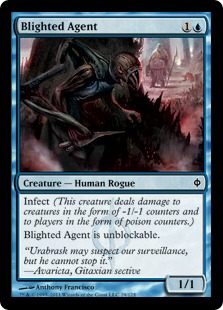 is partially that it can't sculpt the game to its advantage using information from Probe, and also because cheap removal became more common. It wasn't that hard to overcome Lightning Bolt, but Fatal Push is another story.
is partially that it can't sculpt the game to its advantage using information from Probe, and also because cheap removal became more common. It wasn't that hard to overcome Lightning Bolt, but Fatal Push is another story.
Horizons promised to change Infect's fortunes with Scale Up. Second only to the setup-required Become Immense in terms of power-for-cost among pump spells, Scale combines with Might of Old Krosa or Groundswell to produce ten poison damage as early as turn 2. This was possible before Scale, but it took two Might/Groundswell and a Mutagenic Growth on Glistener Elf to pull off. The Scale kill requires one fewer card, and that makes it more statistically likely to happen, though the odds are still small.
Prison Strategy
However, that doesn't appear to have been enough. Infect isn't appearing in the aforementioned challenges like Hogaak. Instead, there have been rumblings in the Leagues of Bant Infect. The idea is to use Teferi, Time Raveler to moot opposing interaction, simultaneously making the protection spells like Blossoming Defense more effective. Teferi can also sometimes remove blockers for Glistener Elf to break through. In addition, Teferi gives Infect some long-game potential via card drawing.
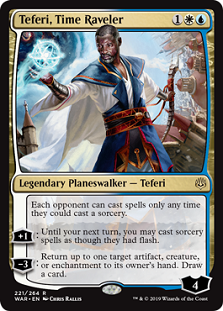 While they haven't made the standings, I've also seen some pilots go further by playing Giver of Runes. Spellskite has long been played as creature protection, but Giver can also make creatures unblockable. True, Giver can only be used once per turn, and not immediately. But she's also cheaper and can protect from more things than Spellskite; protecting from creatures aside, Giver can save a creature from Kolaghan's Command or Pyroclasm where Spellskite couldn't, for example.
While they haven't made the standings, I've also seen some pilots go further by playing Giver of Runes. Spellskite has long been played as creature protection, but Giver can also make creatures unblockable. True, Giver can only be used once per turn, and not immediately. But she's also cheaper and can protect from more things than Spellskite; protecting from creatures aside, Giver can save a creature from Kolaghan's Command or Pyroclasm where Spellskite couldn't, for example.
The combination of Teferi and Giver conspires to give Bant Infect a prison-like plan. This isn't a Whir Prison-style hard lock, but instead Infect is trying to lock opponents out of the one thing that matters in the match, interaction, and then ride that lock to victory. In theory, this is effective repositioning for Infect and could help it return to the metagame.
Papering Over Problems
However good of an idea the additional protection and faster kill potential is, it doesn't actually solve Infect's problems. Infect is a deck with a fundamental weakness: it relies on 12 1/1 creatures to win the game. To do its thing, it must draw the right combination of intrinsically weak creatures and payoff spells, a condition it shares with Boggles. Infect frequently has to mulligan aggressively, 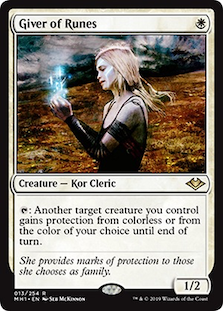 which leaves it resource-poor, a brutal result for a critical-mass deck. Removing pump spells for Teferi or Giver arguably worsens this predicament. Scale's raw efficiency reduces the need for other pump spells, but can't eliminate it, and can make things worse should the non-stacking Scale appear in multiples.
which leaves it resource-poor, a brutal result for a critical-mass deck. Removing pump spells for Teferi or Giver arguably worsens this predicament. Scale's raw efficiency reduces the need for other pump spells, but can't eliminate it, and can make things worse should the non-stacking Scale appear in multiples.
There's also the fact that Teferi and Giver don't add much protection-wise. Infect was not hurting for creature protection between Defense, Vines of Vastwood, and Apostle's Blessing. The advantage of Giver and Teferi is they cost no mana on the kill turn, but they have to be played beforehand, and so won't be a surprise. Teferi also doesn't stop sorcery-speed removal, and therefore, he only actually shields Inkmoth Nexus.
Old Weaknesses, New Vulnerabilities
Experienced players know that you don't kill Infect's creatures in or around the combat step. Doing so lets Infect get additional value from playing Blossoming Defense in response to the removal spell. Instead, wait until Infect's end step or your own turn. You also want to kill infectors at the earliest opportunity. Therefore, Teferi will have no practical impact on Blighted Agent or Glistener Elf surviving to attack. Giver must be in play before the infector to protect them, which means that there will be more opportunities to Thoughtseize them, which can 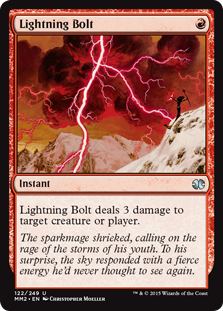 be fatal for Infect. In other words, the new cards don't alter the playstyle against Infect.
be fatal for Infect. In other words, the new cards don't alter the playstyle against Infect.
Going Bant also makes Infect vulnerable to Blood Moon in a way it wasn't previously. Moon was never very good against Infect, since the infectors came down first, and being two-color, it was easy to fetch around Moon. The play patterns I've seen from Bant Infect so far indicate that Moon is suddenly devastating against them. Trying to set up Giver and/or Teferi protection slows the deck down, often by a turn or more. This gives opponents the time needed to land Moon, and since Bant Infect plays fewer basics than UG, it is often a hard lock. I've seen many Infect players try to resolve Teferi intending to kill with Nexus the following turn only to have him countered or removed then be locked and lose to Blood Moon. In the end, the fastest Infect kill is slightly more likely, but I'm seeing the average kill turn decrease slightly. I'm not certain where this leaves the deck.
Implications and Impacts
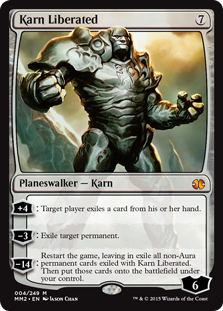 Even if the new protection spells don't work out for Infect, I would expect the appeal of the fast kill to renew interest in the strategy. It's unlikely to become the boogeyman it once was, but having Infect around puts pressure on decks to be more interactive. Creature decks like Humans tend to struggle against Infect for this reason, as does Tron. Since both are expected to be boosted by the London Mulligan, it could be healthy for the metagame to introduce another predator.
Even if the new protection spells don't work out for Infect, I would expect the appeal of the fast kill to renew interest in the strategy. It's unlikely to become the boogeyman it once was, but having Infect around puts pressure on decks to be more interactive. Creature decks like Humans tend to struggle against Infect for this reason, as does Tron. Since both are expected to be boosted by the London Mulligan, it could be healthy for the metagame to introduce another predator.
The other effect of Infect's return would be to re-incentivize Jeskai Control. Jeskai is another natural predator of creature decks, arguably moreso then UW Control since it's harder to answer waves of cheap spot removal than costly sweepers. Last year, when Jeskai returned, we saw a dip in Humans and an increase in BGx midrange.
Churning On
Spoilers forr Core 2020 have already begun, though at time of writing there's little worth discussing. This will change next week, and then we can start to speculate as this most turbulent of Modern periods grinds on. Perhaps the holes in the new decks will have already been filled by then.




An altogether refreshingly optimistic take on the format, taking into consideration the lessons of the past, rather than sensationally panicking about the current ‘best thing’
And a pleasure to read. Thanks!
I know ban mania is a thing, and it’s not good for the game. However…
I felt your analysis of the hogaak deck didn’t really do it justice. Comparing to a past vengevine deck is all well and good, but there’s significant differences that were just sort of “ignored”.
1. there’s an alt wincon that avoids the GY.
2. The kill turn is quicker, so gives you less time to find an answer.
I realise you mention both of these, but then almost ignore them by saying “I think the deck will follow the same pattern as the last 1”, which really ignores the power those 2 points add.
Lets pretend we’re talking about amulet titan for a second, since that’s my pet deck. If you said “it has an alt wincon (hive mind) and is a turn quicker (summer bloom)” – no-one thought that version of the deck was ok, it’s too much of a power boost, and it got banned because it could kill before you could deploy your hate. There was only 1 really great hate card (blood moon), but arguably there’s a tonne of decks that can’t run Leyline of the Void or Rest in Peace. Playing against the deck without Leyline or RIP has felt miserable. It’s currently stifling what you can play in modern, because it’s kill is so fast and it’s resilient to commonly played interaction.
I’d be interested in your counter-argument to the above!
In order:
1. The alternate kill doesn’t actually avoid the graveyard. Yes, you’re sacrificing creatures that are in play. However, they’re only there because you made all the tokens using your graveyard combo. Without the graveyard, the alt-win can only mill a piddly 1-2 cards at a time, and that’s never going to work out.
2. As I argue in the article, the actual kill turn is slightly faster, but the functional kill turn is the same. If Bridgevine was going to win, it did so by hemorrhaging zombies onto the board in the first three turns, usually followed by a concession when that board wasn’t answerable. This is also true of the fast Hogaak kills, so functionally nothing’s really changed. If you’d have been dead to Bridgevine last year, you’re dead to Hogaak this year. No real difference.
I’ve advocated running the permanent graveyard hate like Relic of Progenitus or Rest in Peace over things like Surgical for years because decks like this exist, so I’m not sympathetic to complaints that players now have to. It’s something that needed to be done for a very long time, but players got away with running the weaker options. That’s not going to work out anymore, so now they’ll have to adopt the options they should have been running in the first place.
Hogaak isn’t like Amulet Titan or other combo decks. There’s no excuse for not running hard graveyard hate, but there’s very limited hate for Amulet or similar decks, so just losing to them is forgivable. No deck ever had to lose to Dredge when Relic and Tormod’s Crypt exist; being weak to them was a choice. Now they’re facing the consequences of that choice.